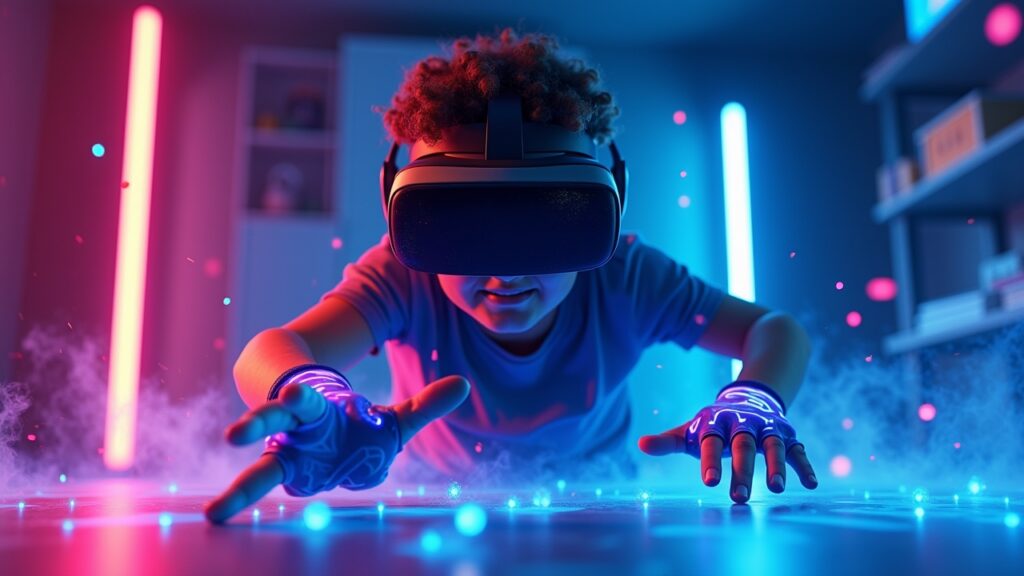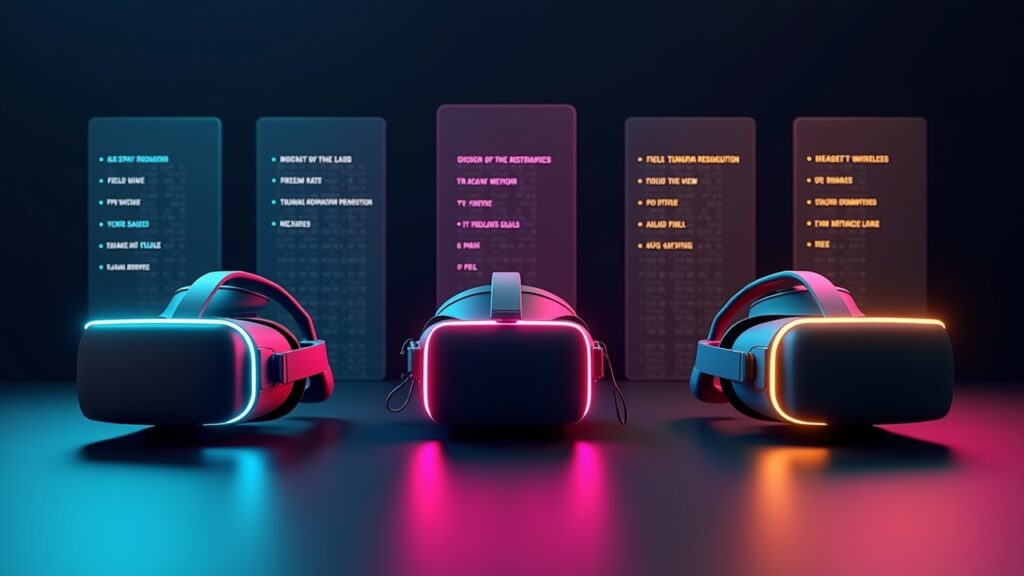Advertisements
Did you know that over 171 million people worldwide are expected to use VR by 2025? I nearly dropped my coffee when I read that stat!
Listen, I’ve been through the ringer with VR headsets this year. From motion sickness that had me questioning my life choices to moments of pure awe that made me forget I was standing in my living room. If you’re looking to dive into virtual reality in 2025, you’ve gotta know what you’re getting into.
The market’s absolutely exploded with options, and trust me, not all headsets are created equal. I’ve tested pretty much everything out there (my credit card still hasn’t forgiven me), and I’m here to share what actually matters when you’re shopping for one.
The Big Players: Meta Quest 3 vs Apple Vision Pro

Okay, let’s start with the heavyweight bout everyone’s talking about. The Meta Quest 3 hit my doorstep first, and wow, what a difference from the Quest 2!
The pancake lenses are a game-changer – seriously, the clarity made me do a double-take. At $499, it’s not exactly pocket change, but compared to what’s coming next… well, it feels like a bargain. The mixed reality features had me rearranging virtual furniture in my actual room, which was trippy as heck.
Then there’s the Apple Vision Pro. Look, when I unboxed this $3,499 beast, my hands were literally shaking. The build quality is insane – it feels like something from a sci-fi movie. But here’s the thing: after using it for a week, my neck was killing me from the weight, and the battery life? Don’t get me started.
The eye tracking on the Vision Pro is mind-blowing though. I caught myself just staring at icons to select them, feeling like I had superpowers. But for gaming? The Quest 3 wins hands down with its massive library and wireless freedom.
Budget-Friendly Options That Don’t Suck
Not everyone’s got thousands to drop on a headset, and that’s totally fine! The PSVR2 has been my go-to recommendation for console gamers.
At $549, it’s reasonable if you already own a PS5. The haptic feedback in the headset itself? Chef’s kiss. Playing Horizon Call of the Mountain, I actually felt the rain on my virtual face – it was wild. Though being tethered to the console can be annoying when you’re really getting into Beat Saber.
For PC enthusiasts on a budget, the Pico 4 Ultra surprised me. It’s basically doing what the Quest 3 does but for about $100 less. Sure, the software ecosystem isn’t as polished, but if you’re mainly using it for PCVR through Virtual Desktop, who cares?
Performance and Specs: What Actually Matters
Here’s where I’m gonna save you from my mistakes. Resolution numbers sound impressive, but refresh rate is what’ll keep your lunch down. Trust me on this one.
The Quest 3 rocks a 120Hz refresh rate, and after switching from 90Hz, I can’t go back. It’s like the difference between watching a movie at 24fps versus 60fps – everything just flows better. The Vision Pro technically has better resolution, but most apps don’t even utilize it fully yet.
Field of view is another biggie. The Quest 3 hits about 110 degrees horizontal, which finally doesn’t feel like looking through binoculars. The PSVR2 actually edges it out slightly at 110-120 degrees, depending on your face shape (yeah, that’s a thing).
Battery life varies wildly too. My Quest 3 gives me about 2-3 hours of gaming, while the Vision Pro barely makes it past 2 hours with normal use. Pro tip: get a battery pack that straps to the back – it balances the weight AND extends playtime.
Content Libraries: Where the Magic Happens

Hardware’s only half the story. Without good content, you’ve got an expensive paperweight.
Meta’s got this locked down with the Quest Store. From fitness apps like Supernatural (my morning workout routine now!) to social experiences like VRChat, there’s something for everyone. Plus, the ability to sideload Android apps opens up tons of possibilities.
Apple’s taking a different approach with productivity-focused apps. Editing documents in 3D space sounds cool, but honestly? It gave me a headache after 30 minutes. Their entertainment offerings are growing though – watching movies on a virtual IMAX screen is pretty sweet.
PSVR2’s strength lies in exclusive PlayStation titles. Gran Turismo 7 in VR had me white-knuckling my controller like never before. But the overall library is smaller, which might be a dealbreaker for some.
Making Your Choice: Real Talk
After all my testing, here’s my honest take. If you want the best all-around experience without breaking the bank, grab the Quest 3. It’s versatile, has tons of content, and doesn’t require any additional hardware.
Got deep pockets and love cutting-edge tech? The Vision Pro is impressive but feels more like a glimpse into the future than a practical purchase today. Maybe wait for version 2?
Already own a PS5? The PSVR2 is a no-brainer for exclusive gaming experiences. Just know you’re limiting yourself to PlayStation’s ecosystem.
Whatever you choose, remember that comfort matters more than specs. Try before you buy if possible – what works for my face might not work for yours. And please, for the love of all things virtual, take breaks every 30 minutes. Your eyes will thank you!
Ready to dive deeper into the world of gaming and tech? Check out more honest reviews and guides at Adpuran – we’ve got your back on everything from streaming setups to the latest gaming gear!




[…] more gaming tips and tech guides? Check out other posts on Adpuran where we break down complex tech stuff into bite-sized, actually useful advice. Happy […]